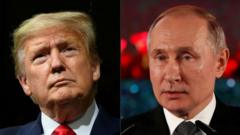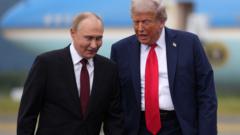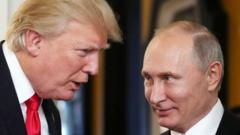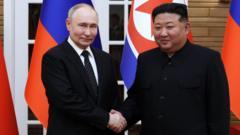The United States has signaled it may impose further tariffs on India depending on the results of President Trump’s upcoming meeting with Russian President Vladimir Putin regarding the Ukraine conflict.
US Threatens India with More Tariffs Amid Trump-Putin Peace Talks

US Threatens India with More Tariffs Amid Trump-Putin Peace Talks
As tensions rise over Ukraine, the US warns India of impending tariffs contingent on diplomatic outcomes.
US Treasury Secretary Scott Bessent recently indicated that if the talks falter, tariffs on India could see an increase. In an interview, he mentioned, “We've put secondary tariffs on Indians for buying Russian oil. If things don't go well, then sanctions or secondary tariffs could go up” following Trump’s meeting with Putin in Alaska. Earlier this month, a 25% penalty was imposed on India, reflecting the US's anger over its purchasing of oil and military equipment from Russia.
The US government has been actively mediating for a ceasefire in Ukraine, with Trump publicly warning of “severe consequences” should Russia not participate in peace negotiations. The upcoming Trump-Putin dialogue in Anchorage aims to discuss an end to the ongoing violence in Ukraine.
Bessent emphasized the need for European allies to join the US in sanctioning India, stating, “The Europeans need to be willing to put on these secondary sanctions.” India's increased importation of discounted Russian oil has sparked tensions between India and the US, especially as it has disrupted ongoing trade talks.
In 2024, Russian oil made up a significant portion of 35% to 40% of India's oil imports, a drastic rise from just 3% in 2021. India has justified its oil purchases, arguing as a major energy importer, it must prioritize cheaper crude to shield low-income citizens from soaring prices.
Bessent’s remarks come after his description of India as "a bit recalcitrant" in trade discussions. Trump claims that these tariffs are essential for enhancing the US economy and creating fairer global trade conditions. He has accused India of tariff abuse and aims to alleviate a $45bn trade deficit between the two nations.
Negotiations between India and the US have been ongoing for several months, with US officials scheduled to visit India later this month. However, analysts note that India's resistance to lowering tariffs on agricultural and dairy goods has stalled progress. The new 50% tariff set to take effect in late August raises concerns about its impact on India's trade-friendly sectors like textiles and jewelry, potentially reducing India’s economic growth by up to half a percent.






















